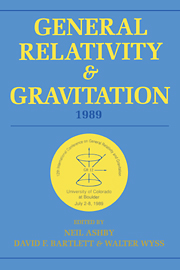 General Relativity and Gravitation, 1989
General Relativity and Gravitation, 1989 Book contents
- Frontmatter
- Contents
- Preface
- Conference committees
- Part A Classical relativity and gravitation theory
- WORKSHOPS
- Part B Relativistic astrophysics, early universe, and classical cosmology
- 5 Gravitational lenses: theory and interpretation
- 6 Recent observations of gravitational lenses
- 7 Inflation and quantum cosmology
- 8 Theory and implications of cosmic microwave background Radiation
- 9 The cosmic microwave background: present status of observations, and implications for general relativity
- WORKSHOPS
- Part C Experimental gravitation and gravitational wave detection
- WORKSHOPS
- Part D Quantum gravity, superstrings, quantum cosmology
- WORKSHOPS
- Part E Overviews-past, present, and future
9 - The cosmic microwave background: present status of observations, and implications for general relativity
Published online by Cambridge University Press: 05 March 2012
- Frontmatter
- Contents
- Preface
- Conference committees
- Part A Classical relativity and gravitation theory
- WORKSHOPS
- Part B Relativistic astrophysics, early universe, and classical cosmology
- 5 Gravitational lenses: theory and interpretation
- 6 Recent observations of gravitational lenses
- 7 Inflation and quantum cosmology
- 8 Theory and implications of cosmic microwave background Radiation
- 9 The cosmic microwave background: present status of observations, and implications for general relativity
- WORKSHOPS
- Part C Experimental gravitation and gravitational wave detection
- WORKSHOPS
- Part D Quantum gravity, superstrings, quantum cosmology
- WORKSHOPS
- Part E Overviews-past, present, and future
Summary
Studies of the ˜ 3K cosmic microwave background or “relict” radiation, discovered 25 years ago, have substantially improved our understanding of cosmology and of the formation of large-scale structure in the universe. Here, I look at the implications of these studies for gravity theory.
I will begin by reviewing the observations, particularly the spectrum and the large-scale isotropy of the radiation. Measurements of the spectrum, when combined with other astrophysical data like the abundance of light nuclei, establish the temperature and expansion rate of the universe at early times. These values in turn may be used to tell us whether unmodified general relativity adequately describes the dynamics of the early universe. Upper limits on any large-scale anisotropy sharply restrict the range of possible anisotropic cosmological models, and provide supporting evidence for a period of “inflationary” expansion early in the universe. The preceding paper by Dr. Panek explores some of these consequences further.
Introduction
It is an honor to have been invited to review the cosmic microwave background radiation (CBR) for this audience. As an observer and experimentalist, I feel particularly privileged since general relativity is sometimes viewed as the province of theoreticians, not those of us with hands dirtied in the laboratory or at thy telescope.
As is well known, the CBR was discovered 25 years ago by Penzias and Wilson (1965).
- Type
- Chapter
- Information
- General Relativity and Gravitation, 1989Proceedings of the 12th International Conference on General Relativity and Gravitation, pp. 223 - 240Publisher: Cambridge University PressPrint publication year: 1990
